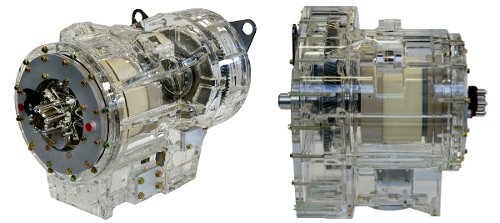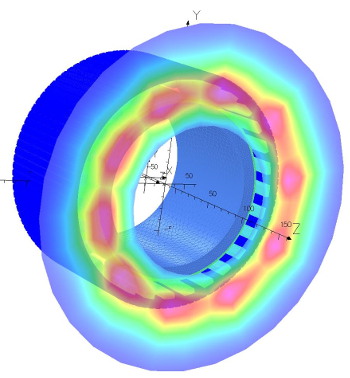 |
| August 19, 2014 | Volume 10 Issue 31 |
Designfax weekly eMagazine
Archives
Partners
Manufacturing Center
Product Spotlight
Modern Applications News
Metalworking Ideas For
Today's Job Shops
Tooling and Production
Strategies for large
metalworking plants
Wheels:
Advanced electromagnetic design tool helps speed commercialization of innovative energy storage system for construction machinery

This demonstrator excavator is fitted with a TorqStor energy storage system (flywheel) that can deliver fuel savings in the region of 10 percent.
The Opera electromagnetic design tool has helped to accelerate commercial development of a new generation of innovative, high-speed flywheel energy storage systems. Created by the technology development company Ricardo, the new energy storage systems are designed to reduce the fuel costs of hydraulically powered construction equipment such as wheeled loaders and excavators. Thanks to the speed and flexibility of Opera software, Ricardo investigated and characterized over 100 different design concepts in just three months before settling on the final design solution that employs a magnetic coupling to rotate a composite flywheel at around 45,000 RPM.
Ricardo's new TorqStor technology stores energy in a carbon-fiber composite flywheel contained within a permanently sealed vacuum chamber, which can be scaled in size to provide energy storage solutions for different equipment. The flywheel is linked by an innovative magnetic coupling and gearing system, and rotates at 45,000 RPM. Integrated with a construction machine's hydraulic power system, TorqStor stores the gravitational energy that is currently unused during the downward movement of the machine's arms or booms, and then uses it to help power subsequent upward movement. This major improvement in operational efficiency enables operators to achieve significant fuel savings and will potentially allow machine manufacturers to use smaller-capacity engines for the same load-moving performance.

Cobham's Opera electromagnetic design software has helped Ricardo to accelerate commercial development of its innovative TorqStor energy storage (flywheel) technology. This real-world demo model shows the active components fitted in a transparent case to allow design engineers to view the operational principle.
When Ricardo first started development of magnetically coupled kinetic energy storage devices a number of years ago, it looked at a number of electromagnetic simulators on the market to help shorten design-to-manufacture times. The Opera package from Cobham Technical Services emerged as the clear favorite because of its scripting flexibility for automating design investigations and ease of interfacing to other software tools, and it is now Ricardo's electromagnetic finite element analysis (FEA) tool of choice.
The first two generations of Ricardo's flywheel energy storage were designed for integration with the powertrains of hybrid and all-electric vehicles, such as cars and buses, to provide traction power. Continuous research, indicating that even higher efficiency gains could be achieved in applications involving frequent energy storage and demand cycles, has now led to the TorqStor development.
Time to market is critical in today's energy-conservation industries, and Ricardo set a demanding three-month target for all magnetic analyses for the TorqStor project. During this period, the development team simulated more than 100 individual design concepts using Opera, each involving successive changes to a wide range of parameters such as material properties and magnet temperatures to examine their effect on torque capacity and magnetic losses. The entire operating cycle of the device needed to be accurately simulated in order to fully evaluate its performance, so relative rather than absolute parameter changes were employed to help minimize analysis time.

Following initial performance analysis in 2D, Ricardo used Opera 3D to investigate end effects to minimize interaction with the flywheel housing.
To further accelerate analysis, Ricardo uses the three-dimensional (3D) version of Opera to initially configure a model and derive data, such as the end-loss factor of the permanent magnets in the TorqStor coupling rotors, then switches to the less computationally intensive 2D version for the bulk of simulation tasks, such as deriving the torque-per-unit length of the flywheel for different configurations. Despite the complexity of the models, each non-linear 2D simulation run typically takes less than 30 minutes, with overnight batch processing further helping to shorten the process. Solutions that meet specific criteria in the design space are then modeled and simulated using Opera 3D to fine tune performance and provide detailed confirmation of results.
The energy storage flywheel in the TorqStor system has a speed of approximately 45,000 RPM and contains a large number of permanent magnets mounted radially around its end face; these couple via stationary pole pieces in the housing to an external rotor that is fitted with a smaller number of magnets, thereby providing non-mechanically linked power transfer and gearing functions.
Optimizing the performance of TorqStor systems has posed considerable design challenges, as Ricardo Development Engineer Joshua Dalby explains: "The lack of mechanical symmetry means that we cannot segment the design and use partial simulation to accelerate the process. Also, the magnetic gears are geometrically linked, which makes it difficult to do a sweep of parameter changes and means that we cannot use auto-optimization tools to eliminate the need for manual intervention. However, thanks to Opera's speed, we have achieved our design goals on schedule. The software's near-seamless mesh control capabilities require minimal input and allow any angular alignment of rotating and stationary parts to be considered. The necessary air gap re-meshing can be controlled from a command script file, which we have found especially helpful -- it has enabled us to evaluate the effect of the two air gaps between the inner and outer rotors and the pole pieces of TorqStor very accurately."
Ricardo's TorqStor technology is already attracting considerable attention. It won a prestigious Tech Award from the SAE (Society of Automotive Engineers) as one of the top five technologies on display at the SAE 2014 World Congress this past April. A 200-kJ capacity prototype of TorqStor was also on show at the recent CONEXPO construction machinery exhibition in March, with the active components fitted in a transparent case to allow design engineers to view the operational principle.
Ricardo estimates that a well-integrated solution in an excavator would deliver fuel savings in the region of 10 percent at typical operating speeds. To put this into perspective, this means that approximately half of the total potential energy that is currently wasted in arm/bucket descent is available for storage and re-use, reducing the amount of fuel burned in the engine. This example solution has a peak power output of 101 kW, a volume of just 221 liters, and weighs less than 100 kg. Ricardo is accepting orders from OEMs and Tier 1 manufacturers for pre-production prototype TorqStor units.
Source: Cobham Technical Services
Published August 2014
Rate this article
View our terms of use and privacy policy
